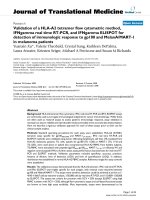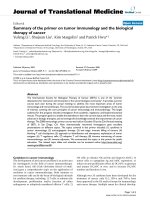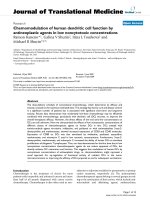Báo cáo hóa học: " Determination of InN/Diamond Heterojunction Band Offset by X-ray Photoelectron Spectroscopy" docx
Bạn đang xem bản rút gọn của tài liệu. Xem và tải ngay bản đầy đủ của tài liệu tại đây (343.59 KB, 5 trang )
NANO EXPRESS Open Access
Determination of InN/Diamond Heterojunction
Band Offset by X-ray Photoelectron Spectroscopy
K Shi
1*
,DBLi
2*
, HP Song
1
, Y Guo
1
, J Wang
1
,XQXu
1
, JM Liu
1
, AL Yang
1
, HY Wei
1
, B Zhang
1
, SY Yang
1
, XL Liu
1*
,
QS Zhu
1
, ZG Wang
1
Abstract
Diamond is not only a free standing highly transparent window but also a promising carrier confinement layer for
InN based devices, yet little is known of the band offsets in InN/diamond system. X-ray photoelectron spectroscopy
was used to measure the energy discontinuity in the valence band offset (VBO) of InN/diamond heterostructure.
The value of VBO was determined to be 0.39 ± 0.08 eV and a type-I heterojunction with a conduction band offset
(CBO) of 4.42 ± 0.08 eV was obtained. The accurate determination of VBO and CBO is important for the application
of III-N alloys based electronic devices.
Introduction
Among the group III nitrides, InN is of great interest
because of its extremely high predicted electron mobility
[1], small effective mass [2,3], and large electro n satura-
tion drift velocity [4]. With the latest progress in
improving the film quality these years, InN film ha s
been considered to be able to meet the requirements for
application to practical devices [5,6]. It is expected to be
a highly promising material for the fabrication of high
performance,high electron mobility transistor (HEMT)
due to its electronic properties. Moreover, the re-evalua-
tion of the InN bandgap and subsequent findings [7,8]
have opened up interesting opportunities for using InN
in new applications, such as high-efficiency solar cells
[9], solid state lighting [10-12], and 1.55 μm emission
for fiber optics [13,14]. As the hardest material with
high optical transparency from ultraviolet to infrared
range, diamond is an excellent transparent window for
InN based photoelectric devices mentioned above. It can
also be used as lens coatings for infrared transmissions.
The bandgap of diamond at room temper ature is
~5.45 eV, so it is a promising carrier confinement layer
for InN based HEMT, which requires a larger bandgap
barrier to confine electrons. Furthermore, because of the
combination of its unique electronic and thermal prop-
erties, diamond plays a vital or somewhat irreplaceable
role in some special appl ications, such as in abominabl e
environments and military fields. Up to now, the GaN/
diamond system has already been studied by a lot of
groups [15,16]. However, there is lack of experimental
data available on the interface band alignment para-
meters for InN/diamond system. X-ray photoelectron
spectroscopy (XPS) has been demonstrated to be a
direct and powerful tool for measuring the valence band
offsets (VBOs) o f heterojunctions [6,17-19]. In this let-
ter, we report an experimental measurement of the
VBO in InN/diamond heterojunction by XPS.
Experimental
Three samples were used in our XPS experiments,
namely, a 350-nm-thick InN layer grown on c-plane
sapphire, a 2-mm-thick single-crystal diamond sy nthe-
sized at high temperature and high pressure(HTHP),
and a ~5-nm-thick InN grown on diamond. InN films
in this study were grown by horizontal lo w-pressure
metal-organic chemical vapor deposition, as reported
elsewhere [19].The crystal struc tures were characterized
using the high-resolution X-ray diffraction (HRXRD)
apparatus at Beijing Synchrotron Radiation Facility
(BSRF). The incident X-ray beam is monochromized to
0.154791 nm by a Si (111) monocrystal. According to
the XRD results, single-crystal diamond (400) and wur t-
zite InN (002) were obtained. Both diamond and InN in
* Correspondence: ; ;
1
Key Laboratory of Semiconductor Materials Science, Institute of
Semiconductors, Chinese Academy of Sciences, P. O. Box 912, 100083,
Beijing, People’s Republic of China.
2
Key Laboratory of Excited State Processes, Changchun Institute of Optics,
Fine Mechanics and Physics, Chinese Academy of Sciences, 16 Dong Nan Hu
Road, 130033, Changchun, People’s Republic of China.
Full list of author information is available at the end of the article
Shi et al . Nanoscale Res Lett 2011, 6:50
/>© 2010 Shi et al. This is an Open Access article distributed under the terms of the Creative Commons Attributi on License
(http://creativecommons .org/licenses/by/2.0), which permits unrestricted use, distribution, and reproduction in any medium, provided
the ori ginal work is properly cited.
our experiment are undoped, while the InN films are
uninte ntionally n-type doped, with carrier concentration
and Hall mobility being 6.2 × 10
19
cm
-3
and 370 cm
2
/Vs
respectively, as determined by Hall effect measurement
in the InN/sapphire film.
The XPS measurements were performed on a
PHI Quantera SXM instrument with Al Ka (energy
1486.6 eV) as the X-ray radiation source, which had
been carefully c alibrated utilizing work function and
Fermi energy level (E
F
). A large number of electrons are
excited and emitt ed from the sample during the test, so
the sample is always positively charged and the conse-
quent electric field can affect the measured kinetic
energy of photoelectron. A low-energy electron flood
gun was utilized to achieve charge compensation. T he
total energy resolution of this XPS system is about
0.5 eV, and the accuracy of the observed binding energy
is within 0.03 eV after careful calibration. The measure-
ments were as follows: first, low-resolution survey scan
mode was used to determine which elements were pre-
sent on the sample surfaces. Then, very-high-resolution
spectra were acquired to determine the binding energy
(i.e., chemical state) in the survey spectra. Since only the
relative energy position in each sa mple is needed to
determinetheVBO,theabsoluteenergycalibrationfor
a sample has no effect on the universal energy reference.
Results and Discussion
The VBO (ΔE
v
) can be calculated from the formula
ΔΔEE E E
EE
V
s
=− −
()
+−
()
CL In d
InN
VBM
InN
C
diamond
VBM
diamond
3
1
52/
(1)
where
ΔEE E
sCL In d
InN
C
diamond
=−
()
31
52/
is the energy
difference between In3d
5/2
and C1s core levels (CLs)
in InN and diamond, which are measured in
the InN/diamond heterojunction.
EE
In d
InN
VBM
InN
3
52/
−
()
and
EE
sC
diamond
VBM
diamond
1
−
()
are the InN and diamond
bulk constants respectively, measured from the two cor-
responding thick films. VBMstandsforvalanceband
maximum. The In3d
5/2
spectra for the InN and InN/dia-
mond samples, the C1s spectraforthediamondand
InN/diamond samples, and the valence band photoemis-
sion for both InN and diamond samples are shown in
Figure 1. All peaks have been fitted using a Shirley back-
ground and Voigt (mixed Lorentzian-Gaussian) line
shapes. The position of the V BM with respect to the
surface Fermi level was determined by the intersection
of linear fitting to the leading edge of the valence band
photoemission and the background [20]. All the
parameters deduced from Figure 1 are summarized in
Table 1 for clarity.
As illustrated in Figure 1a, e, the In3d
5/2
core-level
lineshapes are slightly asymmetric, with a high binding
energy shoulder on the main peaks. This phenomenon
has been reported by several groups [20-22]. Due to the
high carrier density in unintentionally n-type doped InN
and the surface electron accumulation effect, the photo-
emitted electrons will lose energy by coupling with the
free electron plasmas at the surface of the samples. As
we know, plasmons lead to the quantization of a collec -
tive excitation of the electrongasinasolid.Inmetals,
however, Plasmon satellites are commonly observed in
photoemission spectra of core-level peaks on the high
binding energy side. The unrelexed Koopaman’sstate
produced by removal of a core electron is not an ei gen-
state and is projected onto “screened” and “unscreened”
final eigenstates [21], the latter corresponding to a plas-
mon satellite at higher binding energies than the
screened state. The unscreened final state usually gives a
peak with a broader Lorentzian peak profile whose
width reflects the plasmon l ifetime, which in turn
depends on the conduction electron relaxation time
[21]. According to this, we attribute the component
with lower binding energy and smaller half-width to
“screened” final-state, whil e that with higher binding
energy and broader half-width to “unscreened” final-
state, as is shown in Table 1. Indeed, the “unscreened”
higher-binding energy components are much broader
than the “screened” lower-binding energy components
in our XPS spectra. Similar plasmon loss features have
also been observed in the materials SnO
2
when heavily
doped with Sb [23,24], indium-tin-oxide [21] and PbO
2
[25]. Wertheim [26,27] calculated the influence of sur-
face plasmon to binding energy in narrow band metal,
from which we can estimate that influence to our sys-
tem. In Wertheim’s model, the surface plasmon energy,
designated as
sp
is considered to be
sp
=
∞
()
+
()
⎛
⎝
⎜
⎜
⎞
⎠
⎟
⎟
ne
m
2
0
12
1
*
/
(2)
Here n is the carrier concentration, ε(∞)isthehigh
frequency dielectric constant, and m* is the effective
mass of the conduction electrons. Compared with the
metals in his model, the carrier concentration in our
sample surface is much lower, which means that only
small energy separations exist between the screened and
unscreened core-level components. This results in an
asymmetric core-level XPS lineshape w ith just a weak
high binding energy tail due to plasmon losses, which is
consistent with our experimental results.
Shi et al . Nanoscale Res Lett 2011, 6:50
/>Page 2 of 5
Based on all the arguments made above, we attribute
the lower-binding energy component (443.42 eV) in
Figure 1a to the “screened” final-state peak in In3d
5/2
photoemission, the higher-binding energy component
(445.27 eV) to the “unscreened” final-state peak, and the
mid-binding energy component (444.21) to the In–O
bonding. In Figure 1c, the lower-bi nding energy compo-
nent (284.9 eV) and the higher-binding energy compo-
nent (286.00 eV) are considered to be C–C bonding and
C–O bonding respectively [28,29].
In order to avoid the surface oxidation and reduce the
contamination effect, the InN/diamond sample was
Figure 1 In 3d
5/2
Core level XPS spectra for a InN and e InN/diamond samples, and C1s XPS spectra for c diamond and f InN/diamond
samples. b InN and d diamond are the valence band spectra. All peaks have been fitted using a Shirley background and Voigt (mixed
Lorentzian-Gaussian) line shapes, as summarized in Table 1.
Shi et al . Nanoscale Res Lett 2011, 6:50
/>Page 3 of 5
subject ed to a surface clean procedure by Ar
+
bombard-
ment with a voltage of 1 kV at a low sputtering rate of
0.5 nm/min, which alleviates damages to the sample.
The reduced thickness (less than 1 nm) is calculated by
the sputtering rate, and the O-related bondings were
absent in cleaned InN/diamond heterojunction because
of the sputtering process. In Figure 1e, the lower-bind-
ing energy component (442.59 eV) and the higher-bind-
ing energy component (443.50 eV) are attributed to be
screened In–N bonding and u nscreened In-N bonding
respectively. Finally, in Figure 1f, we suggest assign-
ments of screened C–C bonding and unscreened C–C
bonding for the lower- (283.80 eV) and higher-binding
(284.5 0 eV) energy components, respectively. Th e VBM
of the two thick samples are determined to be 0.66 and
1.32 eV, respectively. All of them are summarized in
Table 1.
The lower-binding energy components related to
“screened” final-state are chosen for VBO calculation
because the peak and line width of higher-binding
energy ("unscreened” final-state) depend on the excita-
tion of bulk, surface plasmon, and surface treatment
[22,23]
,
as is mentioned above. The VBO values can be
calculated by substituting those measured values
in Table 1 into Eq. 1. The average InN/diamond
VBO (ΔE
v
)is-0.39±0.08eV.TheCBO(ΔE
C
)isgiven
by the f ormula
ΔΔEE E E
Cg g V
=−
()
−
diamond InN
.Here
E
g
diamond
(~5.45 eV) and
E
g
InN
(~0.64 eV) are respec-
tively the bandgap of diamond and InN at room tem-
perature. S o the band lineup can be determined, with a
conduction band offset (CBO) of 4.42 ± 0.08 eV, as
shown in Figure 2.
As XPS measurements are spatiall y averaged due to
the finite mean free path of elastic electrons (1.5–2 nm),
band bending could induce a systematic error in our
measurements. Due to the lattice mismatch between
InN and diamond, especially the small linear pressure
coefficient of InN (~0.06 meV/GPa) [30], the band gap
change induced by the interface strain could be
neglected. So the systematic error related to band bend-
ing is expected to be much smaller than the average
standard deviation of 0.08 eV given above. Another fac-
tor that may affect the precision of the VBO value is the
strain-induced piezoelectric field in the overlayer of the
heterojunction, as described in the III-nitrides system
[31]. By using the constants and equation in Martin’s
work [31], the field magnitude is estimated to be in the
order of 10
7
V/m. Assuming the heterojunction InN
overlayer thickness of ~4 nm after Ar
+
bombardment,
the error of VBO induced by lattice mismatch is less
than 60 meV. Besides, practically all nitride epitaxial
layers are characterized by dense networks of threading
defects extending from the substrates to the surfaces
[31]
,
the strains in pseudomorphic epi -films relieve
mostly, which me ans the “residual” effect of piezoelec-
tric field is greatly reduced. As a result, the strain-
induced piezoelectric effect can be neglected here.
Table 1 XPS CL spectra fitting results and VBM positions obtained by linear extrapolation of the leading edge to the
extended base line of the VB spectra
Sample State Binding energy (eV) Bonding FWHM (eV)
Diamond C1 s 284.90 C–C 1.21
286.00 C–O 1.89
VBM 1.32 –
InN In 3d
5/2
443.42 In–N (screened) 1.09
444.21 Adsorbed In–O 1.09
445.27 In–N (unscreened) 2.45
VBM 0.66 –
InN/diamond In 3d
5/2
442.59 In–N (screened) 1.26
443.50 In–N (unscreened) 2.19
C1 s 283.80 C–C (screened) 1.28
284.50 C–C (unscreened) 2.43
All the binding energies are referenced to the Fermi level (0 eV)
Figure 2 The VBM and CBM line-up of InN/di amond
heterojunction at room temperature. A type-I band
heterojunction is formed in straddling configuration.
Shi et al . Nanoscale Res Lett 2011, 6:50
/>Page 4 of 5
Conclusions
In summary, the vale nce band offset of the In N/dia-
mond heterojunction has been measured by XPS.
A type-I band alignment with a valence band offset of
ΔE
v
~ 0.39 ± 0.08 eV and conduction band offset of ΔE
c
~ 4.42 eV was obtained. The accura te determination o f
the band alignment of InN/diamond indicates that the
diamond can provide an effective carrier confinement in
InN/diamond based electronic devices.
Acknowledgements
The authors are grateful to Professor Huanhua Wang and Dr. Tieying Yang in
the Institute of High Energy Physics, Chinese Academy of Sciences. This
work was supported by the 863 High Technology R&D Program of China
(Grant Nos. 2007AA03Z402 and 2007AA03Z451), the Special Funds for Major
State Basic Research Project (973 program) of China (Grant No.
2006CB604907), and the National Science Foundation of China(Grant Nos.
60506002 and 60776015).
Author details
1
Key Laboratory of Semiconductor Materials Science, Institute of
Semiconductors, Chinese Academy of Sciences, P. O. Box 912, 100083,
Beijing, People’s Republic of China.
2
Key Laboratory of Excited State
Processes, Changchun Institute of Optics, Fine Mechanics and Physics,
Chinese Academy of Sciences, 16 Dong Nan Hu Road, 130033, Changchun,
People’s Republic of China.
Received: 26 July 2010 Accepted: 10 September 2010
Published: 30 September 2010
References
1. Polyakov VM, Schwierz F: Appl Phys Lett 2006, 88:032101.
2. Fu SP, Chen YF: Appl Phys Lett 2004, 85:1523.
3. Chang Y-M, Chu HW, Shen CH, Chen HY, Gwo S: Appl Phys Lett 2007,
90:072111.
4. Bhuiyan AG, Hashimoto A, Yamamoto A: J Appl Phys 2003, 94:2779.
5. Mahmood ZH, Shah AP, Kadir A, Gokhale MR, Ghosh S, Bhattacharya A,
Arora BM: Appl Phys Lett 2007, 91:152108.
6. Wu C-L, Shen C-H, Gwo S: Appl Phys Lett 2006, 88:032105.
7. Davydov VY, et al: Phys Stat Sol B 2002, 234:787.
8. Haller EE, Lu H, Schaff WJ: Phys Rev B 2002, 66:201403.
9. Wu J, Walukiewicz W, Yu KM, Shan W, Ager JW, Haller EE, Lu H, Schaff WJ,
Metzger WK, Kurtz S: J Appl Phys 2003, 94:6477.
10. Shih CF, Chen NC, Chang CA, Liu KS: Jpn J Appl Phys 2005, 44:L140.
11. Zheng XH, Chen H, Yan ZB, Li DS, Yu HB, Huang Q, Zhou JM: J Appl Phys
2004, 96:1899.
12. Enya Y, Yoshizumi Y, Kyono T, Akita K, Ueno M, Adachi M, Sumitomo T,
Tokuyama S, Ikegami T, Katayama K, Nakamura T: Appl Phys Express 2009,
2:082101.
13. Che SB, Mizuno T, Wang X, Ishitani Y, Yoshikawa A: J Appl Phys 2007,
102:083539.
14. Yoshikawa A, Che SB, Yamaguchi W, Saito H, Wang XQ, Ishitani Y,
Hwang ES: Appl Phys Lett 2007, 90:073101.
15. Hageman PR, Schermer JJ, Larsen PK: Thin Solid Films 2003, 443:9.
16. Oba M, Sugino T: Jpn J Appl Phys 2000, 39:L1213.
17. Chen J-J, Gila BP, Hlad M, Gerger A, Ren F, Abernathy CR, Pearton SJ: Appl
Phys Lett 2006, 88:042113.
18. King PDC, Veal TD, Jefferson PH, McConville CF, Wang T, Parbrook PJ, Lu H,
Schaff WJ: Appl Phys Lett 2007, 90:132105.
19. Zhang PF, Liu XL, Zhang RQ, Fan HB, Song HP, Wei HY, Jiao CM, Yang SY,
Zhu QS, Wang ZG: Appl Phys Lett
2008, 92:042906.
20. King PDC, Veal TD, Payne DJ, Bourlange A, Egdell RG, McConville CF: Phys
Rev Lett 2008, 101:116808.
21. Christou V, Etchells M, Renault O, Dobson PJ, Salata OV, Beamson G,
Egdell RG: J Appl Phys 2000, 88:5180.
22. King PDC, Veal TD, Lu H, Hatfield SA, Schaff WJ, McConville CF: Surf Sci
2008, 602:871.
23. Egdell RG, Walker TJ, Beamson G: J Electron Spectrosc Relat Phenom 2003,
128:59.
24. Egdell RG, Rebane J, Walker TJ, Law DSL: Phys Rev B 1999, 59:1792.
25. Payne D, Egdell R, Hao W, Foord J, Walsh A, Watson G: Chem Phys Lett
2005, 411:181.
26. Wertheim GK: Chem Phys Lett 1979, 65:377.
27. Campagna M, Wertheim GK, Shanks HR, Zumsteg F, Bank E: Phys Rev Lett
1975, 34:738.
28. Ballutaud D, Simon N, Girard H, Rzepka E, Bouchet-Fabre B: Diam Relat
Mater 2006, 15:716.
29. Humbert B, Hellala N, Ehrhardt JJ, Barrat S, Bauer-grosse E: Appl Surf Sci
2008, 254:6400.
30. Wu J, Walukiewicz W, Yu KM, Ager JW III, Haller EE, Lu H, Schaff WJ, Saito Y,
Nanishi Y: Appl Phys Lett 2002, 80:3967.
31. Martin G, Botchkarev A, Rockett A, Morkoc H: Appl Phys Lett 1996, 68:2541.
doi:10.1007/s11671-010-9796-6
Cite this article as: Shi et al.: Determination of InN/Diamond
Heterojunction Band Offset by X-ray Photoelectron Spectroscopy.
Nanoscale Res Lett 2011 6:50.
Submit your manuscript to a
journal and benefi t from:
7 Convenient online submission
7 Rigorous peer review
7 Immediate publication on acceptance
7 Open access: articles freely available online
7 High visibility within the fi eld
7 Retaining the copyright to your article
Submit your next manuscript at 7 springeropen.com
Shi et al . Nanoscale Res Lett 2011, 6:50
/>Page 5 of 5









